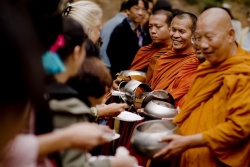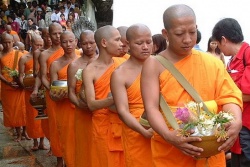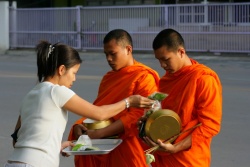Difference between revisions of "A Brief Introduction to Thai Buddhism"
m (Text replacement - "the Buddha" to "the Buddha") |
m (Text replacement - "Southeast {{Wiki|Asia}}" to "{{Wiki|Southeast Asia}}") |
||
| Line 8: | Line 8: | ||
[[Buddhism in Thailand]] has flourished under patronage of the crown, with many members of the royalty entering the [[Order]] for a [[time]]. In the Sukhothai period, the Supreme [[Patriarch]] was appointed by the king and oversaw the [[monkhood]] or [[Sangha]]. [[The Sangha]] itself was hierarchically organized in rough correspondence to civil administration. In the early [[Thai]] [[Sangha]], there appear to have been two main groups involved in different activities inherited from earlier [[Buddhist]] and Singhalese [[traditions]], the gamavasi, or “city-dwelling” [[monks]], and the araññavasi, or “forest-dwelling” [[monks]]. The two groups have become known for [[being]] involved in two different tendencies in [[Buddhist]] practice, namely gantha dhura, the study of [[books]], and [[vipassana]] dhura, the practice of [[meditation]]. | [[Buddhism in Thailand]] has flourished under patronage of the crown, with many members of the royalty entering the [[Order]] for a [[time]]. In the Sukhothai period, the Supreme [[Patriarch]] was appointed by the king and oversaw the [[monkhood]] or [[Sangha]]. [[The Sangha]] itself was hierarchically organized in rough correspondence to civil administration. In the early [[Thai]] [[Sangha]], there appear to have been two main groups involved in different activities inherited from earlier [[Buddhist]] and Singhalese [[traditions]], the gamavasi, or “city-dwelling” [[monks]], and the araññavasi, or “forest-dwelling” [[monks]]. The two groups have become known for [[being]] involved in two different tendencies in [[Buddhist]] practice, namely gantha dhura, the study of [[books]], and [[vipassana]] dhura, the practice of [[meditation]]. | ||
| − | In early [[Thai]] history, although there existed regional [[religious]] movements that usually formed around a charismatic [[teacher]], there was only one [[order]] within the [[Sangha]]. In the 1830s, however, {{Wiki|Prince}} {{Wiki|Mongkut}}, while a distinguished [[monk]], became dissatisfied with the [[condition]] of [[Buddhism in Thailand]] and sought to reform it according to his reading of the [[Canon]]. He initiated reforms that eventually led to the establishment of a new [[order]] (nikai), called the Thammayut. {{Wiki|Mongkut}} questioned the establishment of [[sacred space]] at [[temple]] grounds and the [[ordination]] procedures that had gone on before, as well as the method of [[chanting]] and wearing of [[robes]], and began ordaining or reordaining [[monks]]. The Thammayut [[order]], due to its claims of purity and orthodoxy, has [[caused]] an enduring tension within the [[Thai]] [[Sangha]]. One [[Thai]] [[scholar]] has called the establishment of this new [[order]] an “awkward” moment in [[Thai]] history. The [[influence]] of this nikai eventually spread to neighboring [[Theravada]] countries in | + | In early [[Thai]] history, although there existed regional [[religious]] movements that usually formed around a charismatic [[teacher]], there was only one [[order]] within the [[Sangha]]. In the 1830s, however, {{Wiki|Prince}} {{Wiki|Mongkut}}, while a distinguished [[monk]], became dissatisfied with the [[condition]] of [[Buddhism in Thailand]] and sought to reform it according to his reading of the [[Canon]]. He initiated reforms that eventually led to the establishment of a new [[order]] (nikai), called the Thammayut. {{Wiki|Mongkut}} questioned the establishment of [[sacred space]] at [[temple]] grounds and the [[ordination]] procedures that had gone on before, as well as the method of [[chanting]] and wearing of [[robes]], and began ordaining or reordaining [[monks]]. The Thammayut [[order]], due to its claims of purity and orthodoxy, has [[caused]] an enduring tension within the [[Thai]] [[Sangha]]. One [[Thai]] [[scholar]] has called the establishment of this new [[order]] an “awkward” moment in [[Thai]] history. The [[influence]] of this nikai eventually spread to neighboring [[Theravada]] countries in {{Wiki|Southeast Asia}} and as far away as [[Sri Lanka]]. Those [[monks]] who had not been reordained became known as the Mahanikai. The differences and undercurrents separating the Thammayut and Mahanikai orders, though hardly distinguishable to the untrained [[eye]], still persist today. |
[[File:DSCF2386.jpg|thumb|250px|]] | [[File:DSCF2386.jpg|thumb|250px|]] | ||
Subsequent “acts” affecting the administration of the [[Sangha]] have been imposed at various points in history by a king or secular authority. The nature of these acts has generally reflected the political tenor of the times. The acts have been the topic of much study and contention by both [[monks]] and laity. How these acts can be updated and made more just is a [[perennial]] [[discussion]]. | Subsequent “acts” affecting the administration of the [[Sangha]] have been imposed at various points in history by a king or secular authority. The nature of these acts has generally reflected the political tenor of the times. The acts have been the topic of much study and contention by both [[monks]] and laity. How these acts can be updated and made more just is a [[perennial]] [[discussion]]. | ||
Revision as of 20:14, 12 September 2013
Theravada Buddhism has been the predominant religion in Thailand since early recorded history. The inscription of King Ramkhamhaeng the Great (1292) mentions that a monk from the southern province of Nakorn Sri Dhammaraja — who had studied the Pali Buddhist Canon (or Tipitaka) from beginning to end — lived at the Forest Temple in the kingdom of Sukhothai and was the Supreme Patriarch (Pali sangharaja) of the monkhood. This statement is one of the earliest statements used by a king to “legitimize” his right to rule in accordance with Buddhist righteousness.
Thai Buddhism, however, is not a mere reflection of the message found in the Pali canon. While some monks may be well versed in certain parts of the canon, most monks are engaged in a variety of creative practices that have become part of the unique nature of Thai Buddhism. Buddhism in Thailand reflects complex traditions of beliefs that have woven themselves into something scholars now generally refer to as a syncretic pattern. Over the years, with varying success, scholars have struggled to make sense of the so-called canonical tradition and the religious practices found at the village level. They have tried to rationalize the presence, persistence, and coexistence of “magical” practices, animistic belief, and Hindu influences found in the Thai landscape. One part of this website will attempt to map out an evolution of scholarship on Thai religion — the development of traditions within circles of Western scholars trying to come to grips with this larger complex of Thai religious practices that can now be called Thai Buddhism. Naturally, some of these scholarly approaches now appear a bit amusing.
Occasionally, Buddhism has required a kind of renewal or refresh. With the decline of Buddhism in India, Sri Lanka became an important Buddhist center under the patronage of King Parakramabahu. Monks were sent from many countries to study the revised Canon there and to receive reordination. Some of these monks — both Sri Lankan and reordained Thai monks — first came to settle in Southern Thailand in Nakorn Sri Dhammaraja and their fame soon spread to Sukhothai. There is speculation as to whether or not the Supreme Patriarch chosen by King Ramkhamhaeng might have been one of these monks. Currently, versions of the Theravada Pali canon are still occasionally compared and studied for accuracy.
Buddhism in Thailand has flourished under patronage of the crown, with many members of the royalty entering the Order for a time. In the Sukhothai period, the Supreme Patriarch was appointed by the king and oversaw the monkhood or Sangha. The Sangha itself was hierarchically organized in rough correspondence to civil administration. In the early Thai Sangha, there appear to have been two main groups involved in different activities inherited from earlier Buddhist and Singhalese traditions, the gamavasi, or “city-dwelling” monks, and the araññavasi, or “forest-dwelling” monks. The two groups have become known for being involved in two different tendencies in Buddhist practice, namely gantha dhura, the study of books, and vipassana dhura, the practice of meditation.
In early Thai history, although there existed regional religious movements that usually formed around a charismatic teacher, there was only one order within the Sangha. In the 1830s, however, Prince Mongkut, while a distinguished monk, became dissatisfied with the condition of Buddhism in Thailand and sought to reform it according to his reading of the Canon. He initiated reforms that eventually led to the establishment of a new order (nikai), called the Thammayut. Mongkut questioned the establishment of sacred space at temple grounds and the ordination procedures that had gone on before, as well as the method of chanting and wearing of robes, and began ordaining or reordaining monks. The Thammayut order, due to its claims of purity and orthodoxy, has caused an enduring tension within the Thai Sangha. One Thai scholar has called the establishment of this new order an “awkward” moment in Thai history. The influence of this nikai eventually spread to neighboring Theravada countries in Southeast Asia and as far away as Sri Lanka. Those monks who had not been reordained became known as the Mahanikai. The differences and undercurrents separating the Thammayut and Mahanikai orders, though hardly distinguishable to the untrained eye, still persist today.
Subsequent “acts” affecting the administration of the Sangha have been imposed at various points in history by a king or secular authority. The nature of these acts has generally reflected the political tenor of the times. The acts have been the topic of much study and contention by both monks and laity. How these acts can be updated and made more just is a perennial discussion.
- Act of 1902
Subsequent “acts” affecting the administration of the Sangha have been imposed on the Sangha by a king or secular authority.
The 1902 Sangha Act by King Chulalongkorn went hand in hand with the civil bureaucratic reforms of the time. It stipulated that there be a body of monks, called the Council of Elders (mahatherasamakhom), which would oversee Sangha affairs and represent different regions of the country. This Act, interestingly, left out the office of the Supreme Patriarch, thus giving the king the last word of approval in matters pertaining to the Sangha. - Act of 1941
The more democratic Sangha Act of 1941 seemed to come as a delayed response to the revolution of 1932 and the end of the absolute monarchy. A more decentralized approach was taken; instead of a Council of Elders, power was separated into various “ministries” or committees (ongkan) that decided on the activities of the Sangha.
The Act stipulated a Supreme Patriarch, but his decisions were subject to the approval of the members of the various committees. However democratic the Act may have appeared, the Supreme Patriarch was still appointed by the king who, as a constitutional monarch, acted on the advice of the government. - Act of 1962
The Sangha Act of 1962 was linked with the rise of Field Marshal Sarit Thanarat and his skepticism regarding the effectiveness of democracy for Thailand. Again, Sangha law reflects this. Along with Sarit’s dissolving the parliament, and doing away with the constitution and political parties, came reforms of the Sangha. Sarit alleged discord within the Sangha and claimed that a tightly organized monkhood would be necessary for the development and advancement of the nation. The office of the Supreme Patriarch was maintained and the Council of Elders re-established. This Act kept the hierarchical administration — from the larger regional structures all the way down to the village level — intact. This Act is still in effect today, and this structure of the Sangha continues to parallel the secular government. It is within this structure that an intricate and often confusing system of honorific rank-titles developed, which continues to play an important role in determining a monk's identity and status.
Some scholarly resources, but don’t get too bogged down in them yet...
Traditionally, ordination in the Sangha is considered a rite of passage for young Thai men, as an essential part of maturity or becoming “ripe” (suk). Ordination can be done on short notice and is not considered a lifetime commitment. Although this pattern of ordination becomes more distorted as one moves towards the urban areas, it is still largely intact in the countryside areas. Boys who are under the age of twenty years may be ordained as novices (Thai, nen; Pali, samanera) and those over this age may receive higher ordination as a full-fledged monk (phra, bhikkhu). The loss of the transmission of the full-fledged female order (bhikkhuni) is being reconsidered by some women in Thailand; this dialog and reconsideration of female roles in the order could be viewed as a modern form of Buddhist feminism.
Gotama Buddha stipulated that monks maintain contact with nearby laity. Contact is primarily made through monks making morning rounds for alms (binthabat) or by participating in ceremonies and rituals. Different temples have their own activities, and the laity have varying amounts of access to monks who reside at each one. Higher-ranking monks and those who have passed the highest grade of Pali studies are given stipends by the government’s Department of Religious Affairs. Often those who attain higher rank stop going out on alms rounds, and food is brought to them. Monks and temples receive donations, depending on the devotion of laity or the monks’ attendance at ritually significant ceremonies. On special occasions, temples may make gifts to other monks and temples. An envelope containing an undisclosed gift of cash (monetary dana), which the monk slips into his bag with an appropriate degree of indifference, is usually a part of each ritual ceremony.
Monks usually decide whether to enter a “forest” temple and study meditation or go to a more urban setting and take up the study of the Buddhist curriculum. Of the latter, even those who ordain temporarily for the traditional three-month “lent” or rainy-season retreat (phansa or vassa), are usually required to begin a program of more formal Buddhist studies (naktham). These studies are divided into three grades that not only teach Buddhist scriptures and doctrine but also the rules of the Sangha bureaucratic order. Aside from naktham studies, there are also nine levels of Pali language study (parian) for which annual examinations are given.
The Sangha education system exists as an alternative for those who wish to engage in religious studies or — for geographical or economic reasons — do not have access to the government system of higher education. Because the government system has not been wholly successful in offering education to the masses, ecclesiastical education still serves as a “path of mobility” for many Thai youth. The Thammayut order has its center of Buddhist studies at Mahamakut Buddhist University, Wat Bovornives, and the Mahanikai monks have theirs at Mahachulalongkorn Buddhist University, Wat Mahathat.
More recently, the image of Thai Buddhism has taken some hard hits. With modernization comes instant media and more instant karmic effects. When a monk in Northern Thailand (Phra Nikorn) was accused of being the father of a patron of his temple, the news spread quickly. When another charismatic figure (Phra Yantra) was suspected of plucking the strings of a new-age harpist while traveling through Europe, great disappointment followed.
While some events like this have always gone on, they do not remain local news any longer. Such publicity has resulted in increasing suspicion and fewer devotees. Some people have continued to criticize the monkhood for its inability to take a stand on pressing modern issues, some saying that monks are too concerned with rank and maintaining the comforts of their own bureaucracy.
Starting with the biography of the Buddha, the spiritual quest has involved a search for the right teacher. Fortunately, many excellent teachers can still be found.
Although the Thai Sangha may be presented as or appear to be a monolithic institution, there is a history of Buddhist movements and reformers who continue to test the boundaries of practices and beliefs in order to keep Buddhism relevant for the current times.


